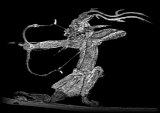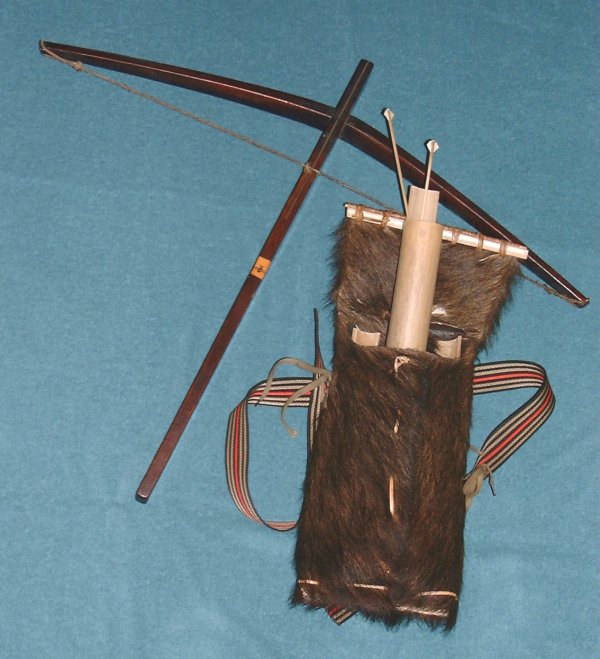

The Crossbows of South-West China
© Stephen Selby, 1999
In 1998, prohibitions on hunting of wild animals in the forests of South-west China aimed at protecting endangered species have probably brought to an end the last instance in the world of the everyday use of the crossbow as a hunting weapon. The tribes of south-west China, wishing to respect the need to conserve their environment, have given up hunting with their crossbows.
There is no real way to address this contradiction. Even the most avid hunter now recognizes the obligation to conserve the species he preys upon. But while species may survive, a species of archery will become extinct. The crossbow archery of the minority peoples of Yunnan will survive in state-sponsored cultural events and shows for tourists; and that is no different from conserving the species in a zoo or a circus: a sort of living death.
An Ankha warrior from Northern Siam (Thailand) shooting with a crossbow.
From 'Die Grosse Völkerkunde' (The Great Races of Mankind)
by Dr. Hugo A. Bernazik, published in Leipzig in 1939.
The state of Dali came under total central Chinese control in the Ming Dynasty (1368 - 1644). The earliest records of the peoples of the south-east concentrate on their expertise with poison arrows. Most of the arrow-poison recipes popular in the Ming Dynasty emanate from the indigenous tribes of Yunnan and Guangxi. But from the beginning of the Qing Dynasty, the Manchu rulers of China consistently remarked on the skill of the south-western huntsmen with the crossbow, dwelling on their ability to shoot mice and small birds with poison-tipped arrows shot from a crossbow. The crossbow was a standard part of the everyday dress of some tribes: particularly the Nu.

Folkloric tapestry of the Dai Nationality, Yunnan (c. 1930)
(Permission of the Museum of National Minorities, Kunming)
Construction.
All the crossbows and arrows of the tribes of Yunnan, Guangxi and North Burma and Thailand appear to follow the same basic pattern and the method of construction hardly varies. The bow itself is always a single piece of hardwood. I have three crossbows from the Nu tribe, supplied by the Tribe’s Delegate to the Chinese National People’s Congress. The length the of the crossbow prods in the three are 87cm, 83cm and 79cm. The prods are made from various species of the mulberry family
In the case of the largest of the three, the general scheme of the design of the prods is –

The height where the prod passes through the stock is 50mm and the thickness is 21mm. At the tip of the prod, the height has been reduced evenly to 22mm and the thickness to 15mm at the string-nock. In all three crossbow prods, the curvature of the back of the prod is greater than on the belly; and in one sample, the belly is virtually flat.
In the largest crossbow, the prods form an almost perfect arc of a circle when strung but not drawn, while in the other two, the prods have very little curvature.
The crossbow body is also a single piece of hardwood – apparently mahogany – of a reddish colour. The stock is the part of the crossbow which tends to have a distinctive shape related to its ethnic source. I shall discuss these shapes later.
The prods pass through the stock of the crossbow through an aperture cut exactly to the profile of the middle of the prod. No nails or glue are employed. In all three Nu crossbow specimens, the thickness of the stock is even throughout its length at 15 - 18mm. The height of the stock at the point where the prod passed through was identical in all three specimens at 65mm. The lengths varied considerably: one was 57cm, one 61cm and one 78cm.
In the top of the stock a channel is carved for the quarrel. The channel was more uniform in length: two were 23cm and one was 26.5cm. In all cases the channel forms a ‘V’ 3mm wide and 3mm deep.

Nu nationality crossbow trigger mechanism.
In all cases the trigger mechanism is extremely simple and effective. A piece of ivory with a notch cut in it is set into the top of the stock and a channel is cut through the stock from the bottom to contain an ivory or bone trigger which rocks on a bamboo pin. (No metal is employed anywhere in the crossbow construction.) The string is pulled back until it slides over the ivory notch and is retained behind it. Pulling back on the trigger with the forefinger causes the top of the ivory trigger to push the string up and off the notch. Tradition has it that the crossbow will only shoot accurately if the trigger mechanism is placed exactly half-way along the stock. All three crossbows I measured conformed to this norm.

Action of the trigger mechanism
There is no sighting mechanism. In use, the hunstman raises the crossbow to eye-level and aims along the length of the stock.
The crossbows typically favoured by the different tribes of Yunnan are virtually identical in construction, and only the profile of the stock distinguishes those of one tribe from those of another.

Display of crossbows from Yunnan.
(Permission of the Museum of National Minorities, Kunming)
PROFILE |
TRIBE |
 |
Yi |
Jingbo |
|
Nu |
|
 |
Lisu |
 |
Hani |
 |
Jinuo |
Typical crossbow stock profiles of Yunnan and Guangxi
(after Yin Shaoting and He Xuehui (see reference at the end.))
The strings of the crossbows are made of hemp and are about 3mm thick. They are of 4-ply and the loops are spliced back into the ply of the string. They are under considerable tension when the bow is not drawn, and the position of the prods below the top of the stock causes a strong downward tension on the string, so that there is considerable friction of the string against the top of the stock as it travels back on release.
To draw one of the crossbows back to 122.5mm requires 21.4Kg (47 pounds). A second one with a draw-length of 180mm went off the scale on my measure at about 44Kg (between 90 and 100 pounds). The third has a draw-length of 130mm and requires 38.6Kg (85 pounds) to pull.

The quarrel is a simple affair. A piece of bamboo 25cm long and 4mm in diameter is sharpened at one end and split 2cm at the other. A piece of bamboo leaf is cut into a rectangular strip about 3.6cm long 6mm wide. The two ends of the rectangle are folded down to form a triangle and the point of the triangle is inserted into the split bamboo with the point towards the point of the arrow and the base of the triangle a couple of millimeters in from the nock. The top of the split is wound a couple of times with thread. The resulting fletching is an equilateral triangle 15mm wide and long. The finished arrow weights 3-4 grams.

Fletching on a contemporary Nu crossbow quarrel
When the crossbow is cocked, the quarrel is set on the groove in the stock, not against the string but with the tip of the arrow adjacent to the end of the stock. Thus the quarrel is not carried up the stock by the string, but hit by the fast-moving string.
An unsharpened quarrel with a flat end of 4mm diameter punched a neat hole through 3mm of heavy card from range of 4.5 metres. The draw-weight of the bow was 21.4Kg (47 pounds).
No case is used to carry the crossbow. The materials appear to be weather-proof. The quarrels are normally kept in closed bamboo tubes containing a wick with poison for the tips, and the tubes are then carried in a bearskin quiver with a strap.

Nu nationality crossbow with bearskin quiver, arrow tubes and arrows.
There are two natural poisons used in conjunction with such crossbows in Yunnan: Aconitum Carmichaeli or Antivaris toxicaria.
For a fuller description of Yunnan tribal crossbow construction and usage, see: Yin Shaoting and He Xuehui (Ed.) "The Material Culture of Yunnan - Gathering , Fishing, Hunting". Yunnan Education Publishing House, 1996 (ISBN7-5415-0987-6/G.806)
Last up-dated July 20, 2000